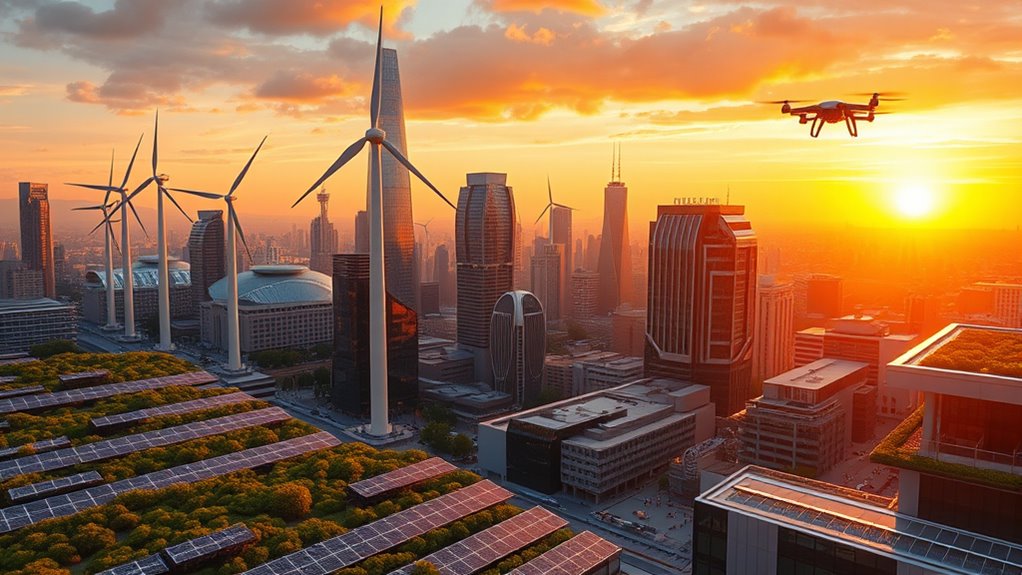By 2025, you’ll see high-tech solutions like advanced carbon capture systems and expanding renewable infrastructure working together to cut emissions and support sustainable growth. These innovations make energy cleaner and more reliable, with modular units added easily to existing sites. As industries and governments invest heavily, you’ll notice smarter, scalable technologies that help manage climate challenges more effectively. Keep exploring to discover how these breakthroughs could transform our planet’s future.
Key Takeaways
- Advanced carbon capture systems, including modular units, are increasingly deployed to reduce industrial emissions efficiently.
- Rapid growth in renewable infrastructure like wind and solar enhances clean energy supply and grid integration.
- Integration of renewable energy with carbon capture technologies enables sustainable, large-scale emissions management.
- Innovations in technology improve scalability, reduce costs, and facilitate seamless addition to existing industrial sites.
- By 2025, smarter, scalable climate tech solutions will significantly cut emissions and foster resilient, sustainable energy systems.

As we approach 2025, climate technology is poised to transform how we address environmental challenges. Innovations in this field are moving beyond theoretical concepts into practical solutions that can make a real difference. One of the most promising areas is carbon capture, which aims to trap greenhouse gases directly from the source or the atmosphere. With advances in this technology, you might see more industrial facilities equipped with carbon capture systems that substantially reduce emissions. These systems are becoming more efficient and cost-effective, making it feasible for companies to adopt them at scale. Alongside carbon capture, renewable infrastructure continues to grow rapidly, reshaping energy grids worldwide. You’ll notice an increase in wind farms, solar arrays, and other renewable sources integrated into existing power networks, reducing reliance on fossil fuels. This shift is essential for lowering overall carbon footprints and combating climate change.
By 2025, carbon capture and renewable energy will reshape efforts to combat climate change.
Moreover, the integration of carbon capture with renewable infrastructure offers a powerful synergy. For example, surplus renewable energy can power direct air capture facilities, which actively remove CO₂ from the atmosphere. This combination allows for a more sustainable approach to managing emissions and could help offset unavoidable industrial emissions. As these technologies develop, you’ll find that their deployment becomes more widespread, improving both environmental and economic outcomes. Governments and private sectors are investing heavily in these solutions, recognizing that scaling up carbon capture and renewable infrastructure is vital for meeting global climate goals. Additionally, maximizing space and organization in deploying these technologies can enhance efficiency and reduce costs, accelerating their adoption.
You might also see innovations in how these technologies are implemented. For instance, modular carbon capture units can be added to existing factories, minimizing disruption while maximizing efficiency. Meanwhile, advancements in renewable infrastructure, such as improved battery storage and smarter grid management, ensure that clean energy remains available even when the sun isn’t shining or the wind isn’t blowing. These developments make renewable energy more reliable and accessible, accelerating the shift away from fossil fuels. As these systems become more integrated and sophisticated, your community could experience cleaner air, improved public health, and more resilient energy supplies.
In essence, by 2025, the landscape of climate tech will be shaped by smarter, more scalable solutions like carbon capture paired with expanded renewable infrastructure. You’ll witness a shift that not only aims to cut emissions but also fosters sustainable growth. These high-tech solutions are designed to be part of the broader effort to create a healthier planet, and their rapid advancement signals a future where tackling climate change becomes more feasible, practical, and effective.
Frequently Asked Questions
How Will Climate Tech Impact Global Economic Inequality?
Climate tech can reduce economic disparity by making sustainable solutions more accessible worldwide. You’ll see technology accessibility improve for underserved communities, opening new job opportunities and fostering innovation. However, if access remains limited to wealthy nations or corporations, it could widen existing inequalities. Your role is vital in advocating for equitable distribution, ensuring climate tech benefits everyone, not just the privileged few, and helping create a more balanced global economy.
What Are the Biggest Regulatory Hurdles for Climate Tech Startups?
You’ll face significant policy barriers, like inconsistent regulations across regions, which slow innovation. About 60% of climate tech startups cite policy uncertainty as a key challenge. Patent challenges also pose hurdles, as protecting intellectual property becomes complex in this evolving field. Overcoming these obstacles requires proactive engagement with policymakers and robust IP strategies, helping you navigate the regulatory landscape and advance your solutions more effectively.
Will Climate Tech Solutions Be Affordable for Developing Countries?
Yes, climate tech solutions can become affordable for developing countries. As technology advances and economies of scale kick in, costs tend to decrease, making these solutions more accessible. You can expect innovative, affordable solutions to help developing countries address environmental issues effectively. Supporting policies, international cooperation, and investments will further reduce costs, ensuring that climate tech benefits reach those who need it most, fostering sustainable growth worldwide.
How Will Climate Tech Innovations Affect Existing Industries?
You’ll see climate tech innovations like renewable energy and carbon capture transform existing industries profoundly. For example, renewable energy adoption could reduce global emissions by up to 70% by 2050. These technologies push industries to become cleaner, more efficient, and sustainable. As you adapt, expect shifts in energy, manufacturing, and transportation sectors, creating new opportunities while challenging traditional practices—making your industry more resilient and environmentally responsible.
What Role Will AI Play in Advancing Climate Technology?
AI innovation will be vital in advancing climate technology by enhancing data analytics capabilities. You’ll see AI help optimize renewable energy systems, predict environmental changes, and improve resource management. By analyzing vast amounts of data quickly, AI empowers you to make smarter, faster decisions that reduce emissions and adapt to climate challenges. This tech accelerates solutions, making climate actions more effective, efficient, and tailored to specific environmental needs.
Conclusion
As you embrace climate tech solutions, imagine towering wind turbines against a clear blue sky, symbolizing hope. Yet, beneath their shadow, discarded plastic and smog remind you of ongoing challenges. These high-tech innovations shine brightly, but your actions matter just as much. By combining advanced technology with mindful choices, you paint a future where harmony replaces chaos. Together, you can turn the stark contrast into a vibrant, sustainable world for generations to come.








